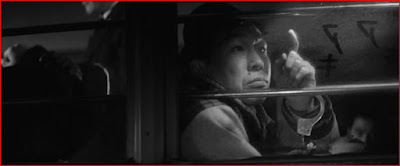The title is the unspoken instruction given to a sniper who sets up an ambush for the title vehicle at the start of the film. He sets a trap by sending an empty truck down a hill to collide with the van containing three prisoners. Suzuki uses the landscape to set the pace and create suspense for this scene, establishing a Burma-Shave like series of warning signs at the start and returning to them to establish where the different vehicles are as the ambush approaches. In any event, two of the prisoners are shot while another escapes in the confusion.
The debacle results in the six-month suspension of Tamon (Michitaro Mizushima), the prison officer responsible for the three men. He takes the discipline in stride because it gives him an opportunity to conduct a one-man freelance investigation. He has plenty of questions to answer. Was the attack meant to kill one or both of the victims, or to free Goro, the one who got away? Or could it have been a botched attempt to kill Goro? And what was the significance of the name "Aki" that Goro kept writing with his finger on the steamed up van window?
"Aki" (upper right)
Tamon's investigation leads him to a "talent agency" that fronts for a prostitution ring, headed by an ailing boss, around whom swirls a struggle for future control pitting the boss's stepdaughter Yuko (Misako Watanabe) against a rival faction. The search for "Aki" becomes a hunt for "Akiba," a mysterious mastermind scheming to take over the agency. Is it a pseudonym for one of Yuko's rivals -- or for Yuko herself? She's shown to be a dangerously proficient marksman with bow or gun, and the most likely suspect in the death-by-arrow of a prostitute Tamon hoped to interview. Despite the obvious danger around her, Tamon finds himself falling for her while still struggling to figure out whether she's trying to help him or kill him.
Who done it? Could it be ... the dame with the bow?
Take Aim is definitely not a youth movie in the way the Ishihara vehicles are -- not with a star in his late forties. But there's still a generational conflict in play as we come to suspect that Yuko is scheming to supplant her father. Tamon also has to deal with the younger generation in the form of a quasi girl-gang, one of whose members may have important information for him, and all of whom are in danger of being recruited into the "talent agency." But the focus here isn't on someone waiting for his life to restart -- Tamon is too proactive and maybe too mature for that. He's older than the typical American noir protagonist, but comes closer to their spirit than do the younger heroes of Nikkatsu's "borderless" films.
This 1960 films finds Suzuki not yet bursting the bounds of genre convention as he'd begin to do in Youth of the Beast and Gate of Flesh. The extra sleaze factor (photographs of topless dancers, the arrow in a woman's breast) may be Suzuki's special contribution, but this is pretty much a straight crime film with elaborate suspense sequences. Besides the titular van attack, the other highlight is a scene out of a cliffhanger serial, as Tamon and Yuko are tied up in the cab of a tanker car which is sent down a road with the fuel cap off. Their enemies light the puddle left behind, starting a race between the truck and a line of flame that could blow our protagonists sky-high. Suzuki cuts ever more rapidly between the fire and the truck from a variety of angles (including the fire seen from the rear-view mirror), as inside Yuko ironically struggles to burn her bonds apart with a cigarette lighter. It's really a silly scene but Suzuki's pacing keeps you interested in how our stars will escape.
While Take Aim is the most nearly noir of the Nikkatsus so far, it's also the weakest of the three I've seen. It gets too bogged down in a convoluted plot while keeping us guessing about Akiba's identity, and it isn't as character-driven as the two Ishihara vehicles. But it is a modestly effective thriller, and like the two previous films, the story could easily be translated into the American idiom. Crime-film fans of global cinema will probably like this one perfectly fine, and now that's a majority of Nikkatsu Noir I can recommend, with two films to go.For that matter, how will this guy escape?






No comments:
Post a Comment